Quadruple Bottom Line Approach to Sustainability: A Case Study of Tohu Wines and Air New Zealand
VerifiedAdded on 2022/11/23
|13
|3698
|82
AI Summary
This paper analyzes the concept of quadruple bottom line approach in the context of Tohu Wines and Air New Zealand. It discusses the importance of purpose in sustainability and provides recommendations for both companies.
Contribute Materials
Your contribution can guide someone’s learning journey. Share your
documents today.
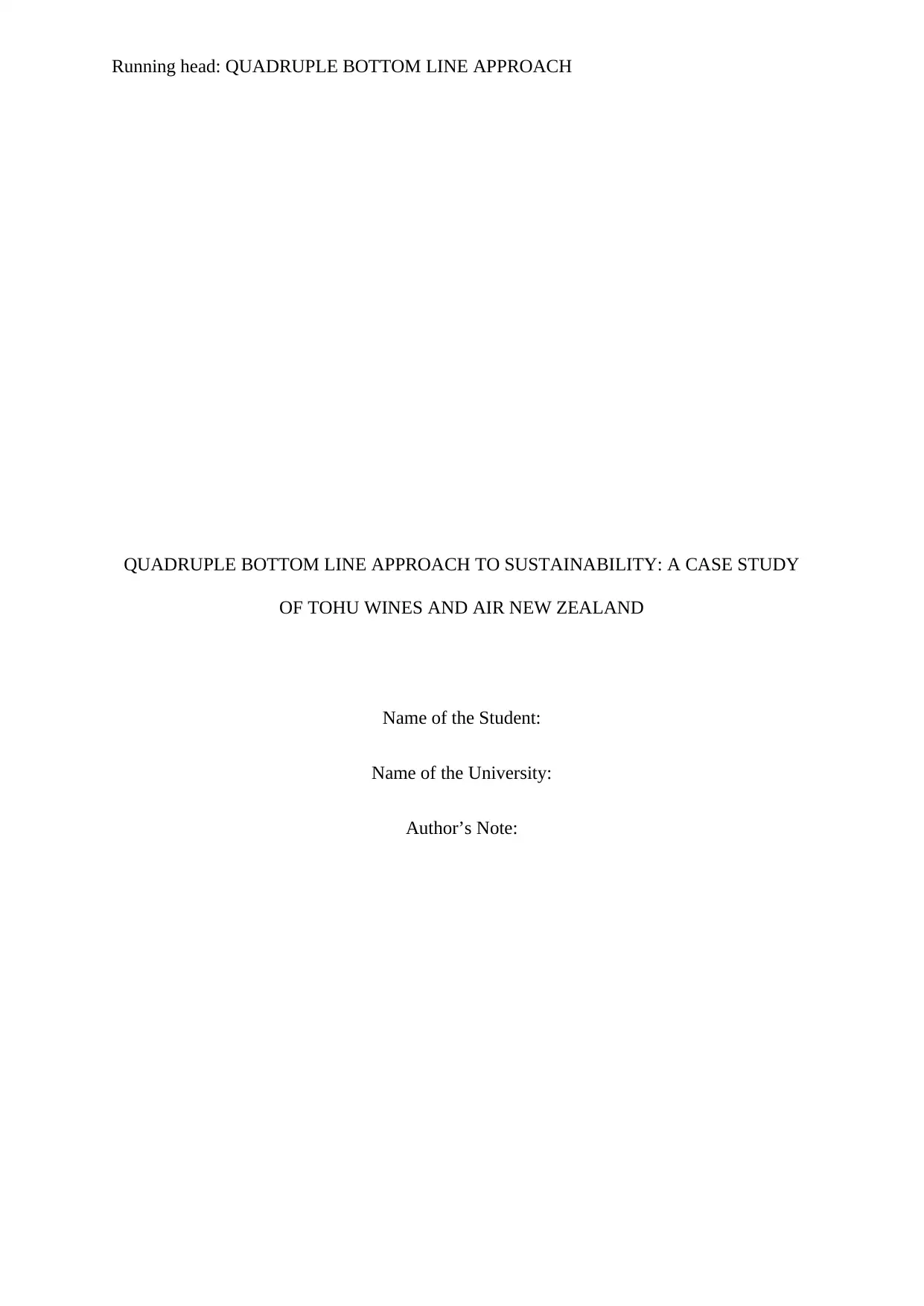
Running head: QUADRUPLE BOTTOM LINE APPROACH
QUADRUPLE BOTTOM LINE APPROACH TO SUSTAINABILITY: A CASE STUDY
OF TOHU WINES AND AIR NEW ZEALAND
Name of the Student:
Name of the University:
Author’s Note:
QUADRUPLE BOTTOM LINE APPROACH TO SUSTAINABILITY: A CASE STUDY
OF TOHU WINES AND AIR NEW ZEALAND
Name of the Student:
Name of the University:
Author’s Note:
Secure Best Marks with AI Grader
Need help grading? Try our AI Grader for instant feedback on your assignments.
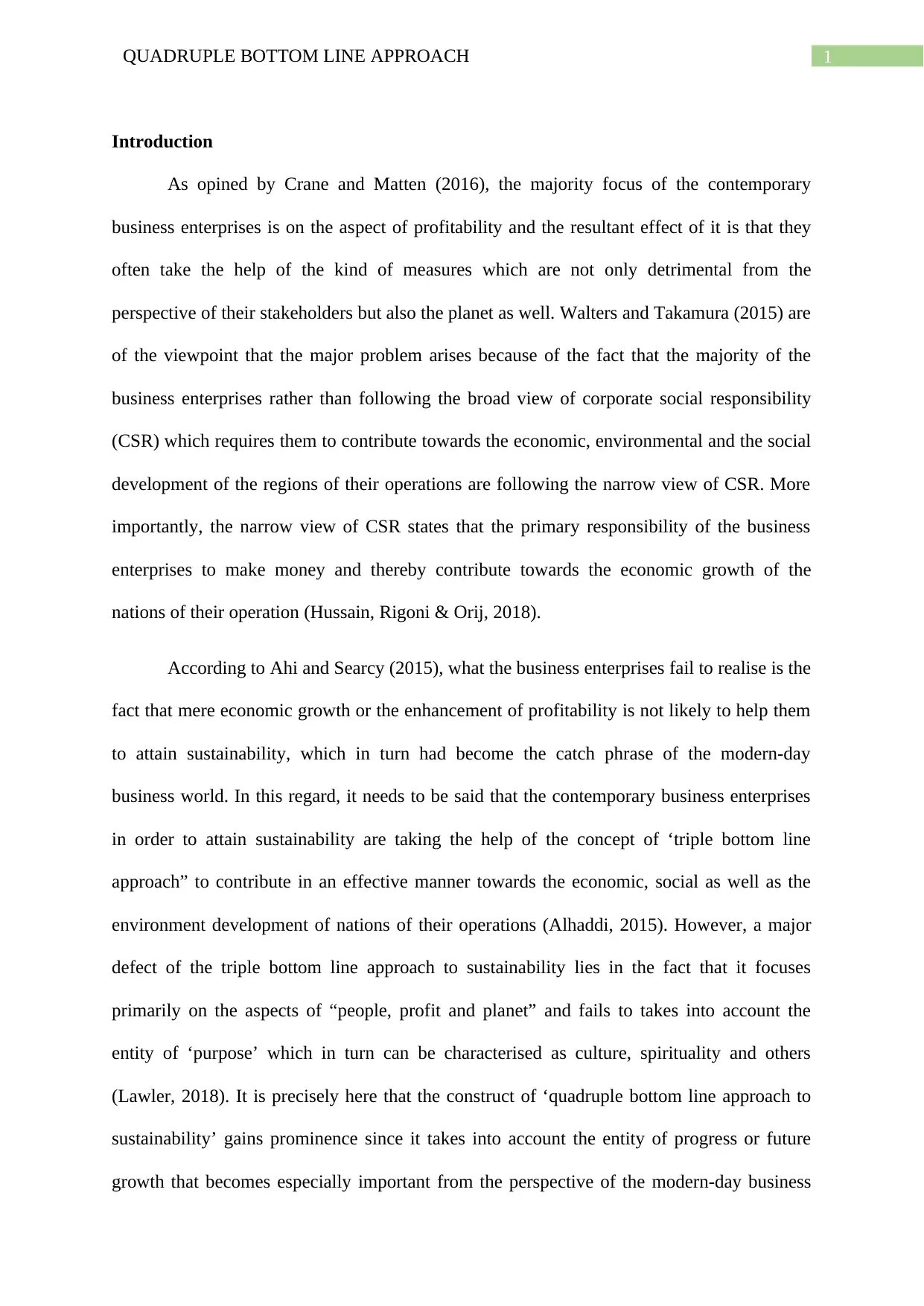
1QUADRUPLE BOTTOM LINE APPROACH
Introduction
As opined by Crane and Matten (2016), the majority focus of the contemporary
business enterprises is on the aspect of profitability and the resultant effect of it is that they
often take the help of the kind of measures which are not only detrimental from the
perspective of their stakeholders but also the planet as well. Walters and Takamura (2015) are
of the viewpoint that the major problem arises because of the fact that the majority of the
business enterprises rather than following the broad view of corporate social responsibility
(CSR) which requires them to contribute towards the economic, environmental and the social
development of the regions of their operations are following the narrow view of CSR. More
importantly, the narrow view of CSR states that the primary responsibility of the business
enterprises to make money and thereby contribute towards the economic growth of the
nations of their operation (Hussain, Rigoni & Orij, 2018).
According to Ahi and Searcy (2015), what the business enterprises fail to realise is the
fact that mere economic growth or the enhancement of profitability is not likely to help them
to attain sustainability, which in turn had become the catch phrase of the modern-day
business world. In this regard, it needs to be said that the contemporary business enterprises
in order to attain sustainability are taking the help of the concept of ‘triple bottom line
approach” to contribute in an effective manner towards the economic, social as well as the
environment development of nations of their operations (Alhaddi, 2015). However, a major
defect of the triple bottom line approach to sustainability lies in the fact that it focuses
primarily on the aspects of “people, profit and planet” and fails to takes into account the
entity of ‘purpose’ which in turn can be characterised as culture, spirituality and others
(Lawler, 2018). It is precisely here that the construct of ‘quadruple bottom line approach to
sustainability’ gains prominence since it takes into account the entity of progress or future
growth that becomes especially important from the perspective of the modern-day business
Introduction
As opined by Crane and Matten (2016), the majority focus of the contemporary
business enterprises is on the aspect of profitability and the resultant effect of it is that they
often take the help of the kind of measures which are not only detrimental from the
perspective of their stakeholders but also the planet as well. Walters and Takamura (2015) are
of the viewpoint that the major problem arises because of the fact that the majority of the
business enterprises rather than following the broad view of corporate social responsibility
(CSR) which requires them to contribute towards the economic, environmental and the social
development of the regions of their operations are following the narrow view of CSR. More
importantly, the narrow view of CSR states that the primary responsibility of the business
enterprises to make money and thereby contribute towards the economic growth of the
nations of their operation (Hussain, Rigoni & Orij, 2018).
According to Ahi and Searcy (2015), what the business enterprises fail to realise is the
fact that mere economic growth or the enhancement of profitability is not likely to help them
to attain sustainability, which in turn had become the catch phrase of the modern-day
business world. In this regard, it needs to be said that the contemporary business enterprises
in order to attain sustainability are taking the help of the concept of ‘triple bottom line
approach” to contribute in an effective manner towards the economic, social as well as the
environment development of nations of their operations (Alhaddi, 2015). However, a major
defect of the triple bottom line approach to sustainability lies in the fact that it focuses
primarily on the aspects of “people, profit and planet” and fails to takes into account the
entity of ‘purpose’ which in turn can be characterised as culture, spirituality and others
(Lawler, 2018). It is precisely here that the construct of ‘quadruple bottom line approach to
sustainability’ gains prominence since it takes into account the entity of progress or future
growth that becomes especially important from the perspective of the modern-day business
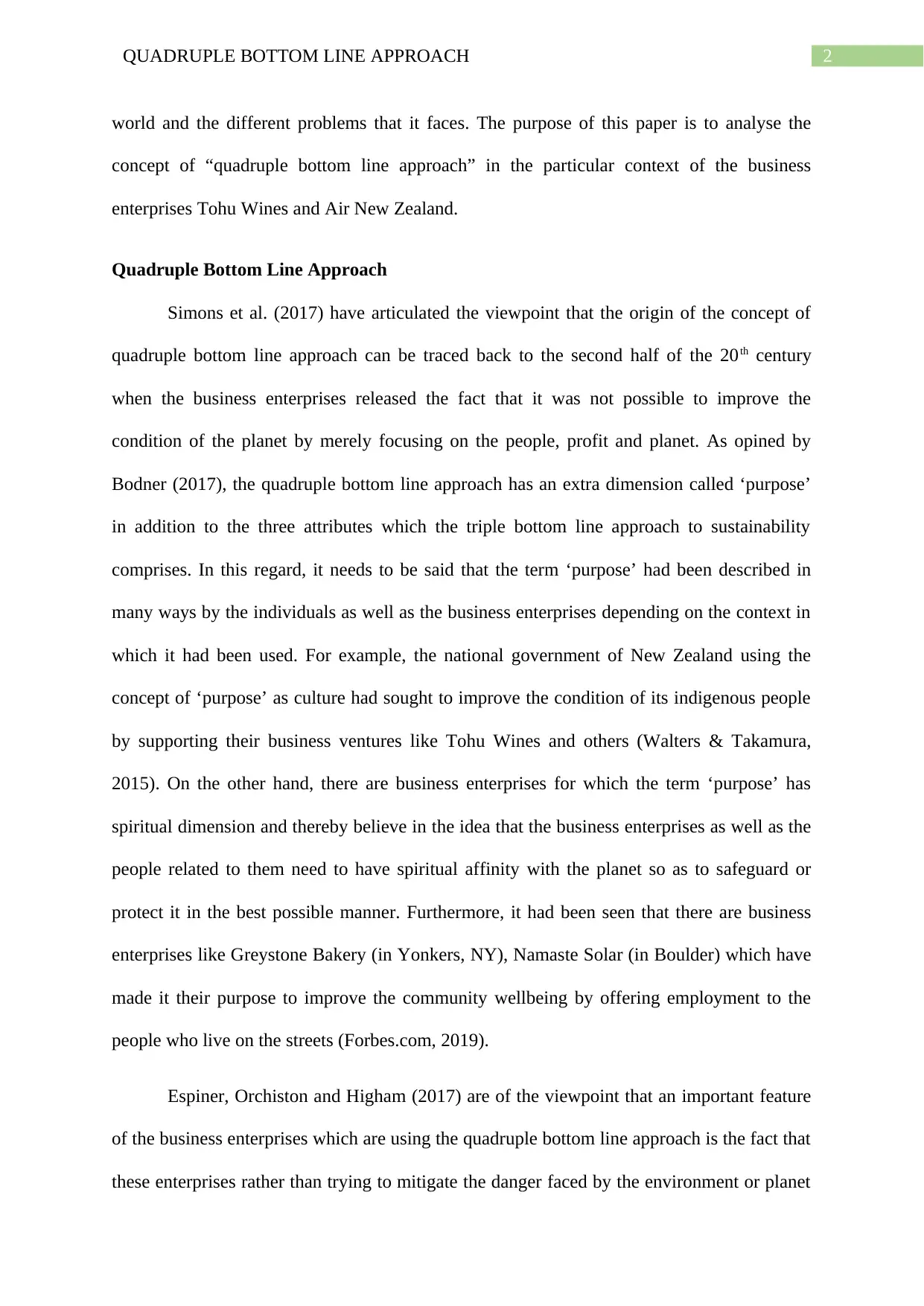
2QUADRUPLE BOTTOM LINE APPROACH
world and the different problems that it faces. The purpose of this paper is to analyse the
concept of “quadruple bottom line approach” in the particular context of the business
enterprises Tohu Wines and Air New Zealand.
Quadruple Bottom Line Approach
Simons et al. (2017) have articulated the viewpoint that the origin of the concept of
quadruple bottom line approach can be traced back to the second half of the 20th century
when the business enterprises released the fact that it was not possible to improve the
condition of the planet by merely focusing on the people, profit and planet. As opined by
Bodner (2017), the quadruple bottom line approach has an extra dimension called ‘purpose’
in addition to the three attributes which the triple bottom line approach to sustainability
comprises. In this regard, it needs to be said that the term ‘purpose’ had been described in
many ways by the individuals as well as the business enterprises depending on the context in
which it had been used. For example, the national government of New Zealand using the
concept of ‘purpose’ as culture had sought to improve the condition of its indigenous people
by supporting their business ventures like Tohu Wines and others (Walters & Takamura,
2015). On the other hand, there are business enterprises for which the term ‘purpose’ has
spiritual dimension and thereby believe in the idea that the business enterprises as well as the
people related to them need to have spiritual affinity with the planet so as to safeguard or
protect it in the best possible manner. Furthermore, it had been seen that there are business
enterprises like Greystone Bakery (in Yonkers, NY), Namaste Solar (in Boulder) which have
made it their purpose to improve the community wellbeing by offering employment to the
people who live on the streets (Forbes.com, 2019).
Espiner, Orchiston and Higham (2017) are of the viewpoint that an important feature
of the business enterprises which are using the quadruple bottom line approach is the fact that
these enterprises rather than trying to mitigate the danger faced by the environment or planet
world and the different problems that it faces. The purpose of this paper is to analyse the
concept of “quadruple bottom line approach” in the particular context of the business
enterprises Tohu Wines and Air New Zealand.
Quadruple Bottom Line Approach
Simons et al. (2017) have articulated the viewpoint that the origin of the concept of
quadruple bottom line approach can be traced back to the second half of the 20th century
when the business enterprises released the fact that it was not possible to improve the
condition of the planet by merely focusing on the people, profit and planet. As opined by
Bodner (2017), the quadruple bottom line approach has an extra dimension called ‘purpose’
in addition to the three attributes which the triple bottom line approach to sustainability
comprises. In this regard, it needs to be said that the term ‘purpose’ had been described in
many ways by the individuals as well as the business enterprises depending on the context in
which it had been used. For example, the national government of New Zealand using the
concept of ‘purpose’ as culture had sought to improve the condition of its indigenous people
by supporting their business ventures like Tohu Wines and others (Walters & Takamura,
2015). On the other hand, there are business enterprises for which the term ‘purpose’ has
spiritual dimension and thereby believe in the idea that the business enterprises as well as the
people related to them need to have spiritual affinity with the planet so as to safeguard or
protect it in the best possible manner. Furthermore, it had been seen that there are business
enterprises like Greystone Bakery (in Yonkers, NY), Namaste Solar (in Boulder) which have
made it their purpose to improve the community wellbeing by offering employment to the
people who live on the streets (Forbes.com, 2019).
Espiner, Orchiston and Higham (2017) are of the viewpoint that an important feature
of the business enterprises which are using the quadruple bottom line approach is the fact that
these enterprises rather than trying to mitigate the danger faced by the environment or planet
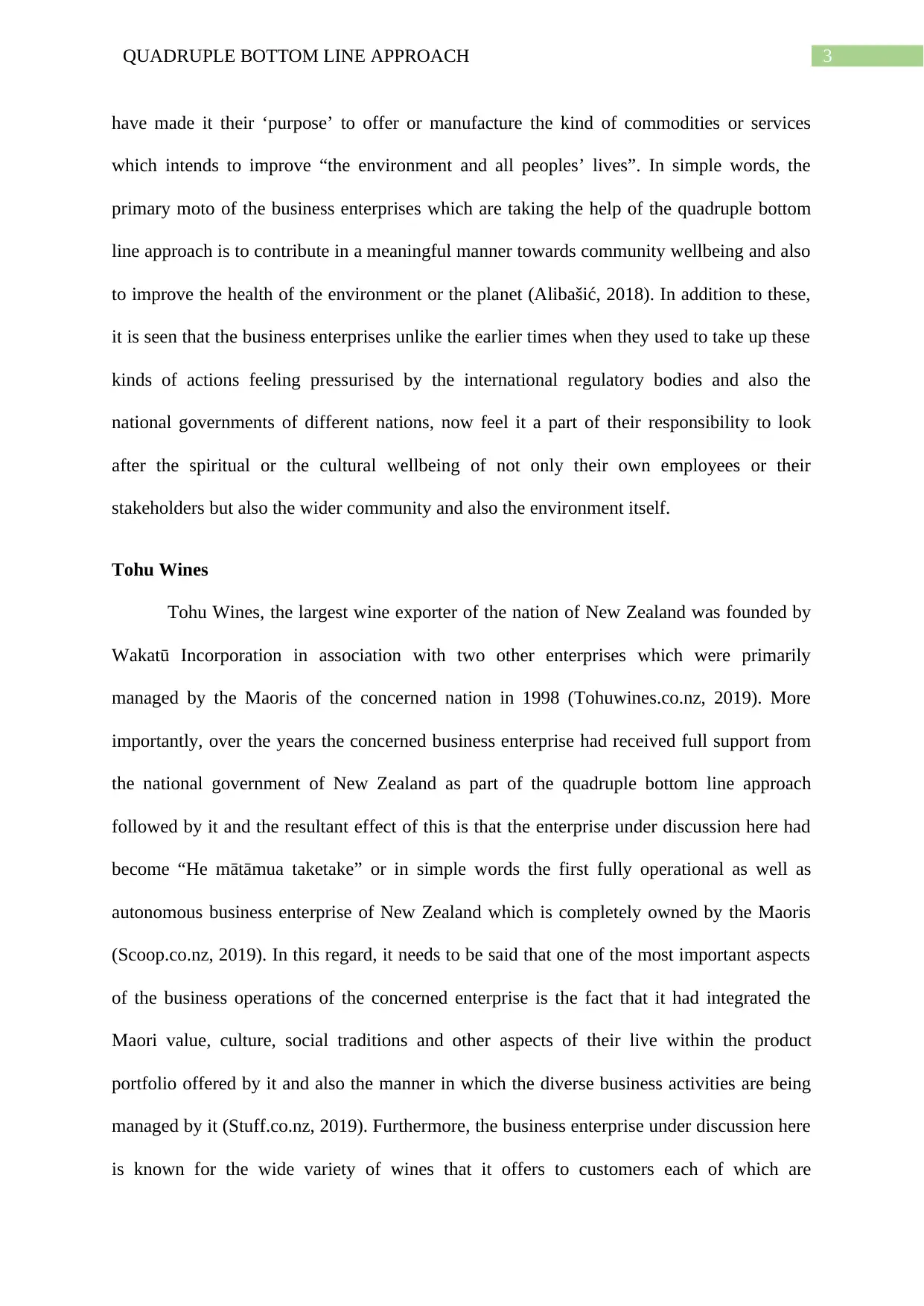
3QUADRUPLE BOTTOM LINE APPROACH
have made it their ‘purpose’ to offer or manufacture the kind of commodities or services
which intends to improve “the environment and all peoples’ lives”. In simple words, the
primary moto of the business enterprises which are taking the help of the quadruple bottom
line approach is to contribute in a meaningful manner towards community wellbeing and also
to improve the health of the environment or the planet (Alibašić, 2018). In addition to these,
it is seen that the business enterprises unlike the earlier times when they used to take up these
kinds of actions feeling pressurised by the international regulatory bodies and also the
national governments of different nations, now feel it a part of their responsibility to look
after the spiritual or the cultural wellbeing of not only their own employees or their
stakeholders but also the wider community and also the environment itself.
Tohu Wines
Tohu Wines, the largest wine exporter of the nation of New Zealand was founded by
Wakatū Incorporation in association with two other enterprises which were primarily
managed by the Maoris of the concerned nation in 1998 (Tohuwines.co.nz, 2019). More
importantly, over the years the concerned business enterprise had received full support from
the national government of New Zealand as part of the quadruple bottom line approach
followed by it and the resultant effect of this is that the enterprise under discussion here had
become “He mātāmua taketake” or in simple words the first fully operational as well as
autonomous business enterprise of New Zealand which is completely owned by the Maoris
(Scoop.co.nz, 2019). In this regard, it needs to be said that one of the most important aspects
of the business operations of the concerned enterprise is the fact that it had integrated the
Maori value, culture, social traditions and other aspects of their live within the product
portfolio offered by it and also the manner in which the diverse business activities are being
managed by it (Stuff.co.nz, 2019). Furthermore, the business enterprise under discussion here
is known for the wide variety of wines that it offers to customers each of which are
have made it their ‘purpose’ to offer or manufacture the kind of commodities or services
which intends to improve “the environment and all peoples’ lives”. In simple words, the
primary moto of the business enterprises which are taking the help of the quadruple bottom
line approach is to contribute in a meaningful manner towards community wellbeing and also
to improve the health of the environment or the planet (Alibašić, 2018). In addition to these,
it is seen that the business enterprises unlike the earlier times when they used to take up these
kinds of actions feeling pressurised by the international regulatory bodies and also the
national governments of different nations, now feel it a part of their responsibility to look
after the spiritual or the cultural wellbeing of not only their own employees or their
stakeholders but also the wider community and also the environment itself.
Tohu Wines
Tohu Wines, the largest wine exporter of the nation of New Zealand was founded by
Wakatū Incorporation in association with two other enterprises which were primarily
managed by the Maoris of the concerned nation in 1998 (Tohuwines.co.nz, 2019). More
importantly, over the years the concerned business enterprise had received full support from
the national government of New Zealand as part of the quadruple bottom line approach
followed by it and the resultant effect of this is that the enterprise under discussion here had
become “He mātāmua taketake” or in simple words the first fully operational as well as
autonomous business enterprise of New Zealand which is completely owned by the Maoris
(Scoop.co.nz, 2019). In this regard, it needs to be said that one of the most important aspects
of the business operations of the concerned enterprise is the fact that it had integrated the
Maori value, culture, social traditions and other aspects of their live within the product
portfolio offered by it and also the manner in which the diverse business activities are being
managed by it (Stuff.co.nz, 2019). Furthermore, the business enterprise under discussion here
is known for the wide variety of wines that it offers to customers each of which are
Secure Best Marks with AI Grader
Need help grading? Try our AI Grader for instant feedback on your assignments.
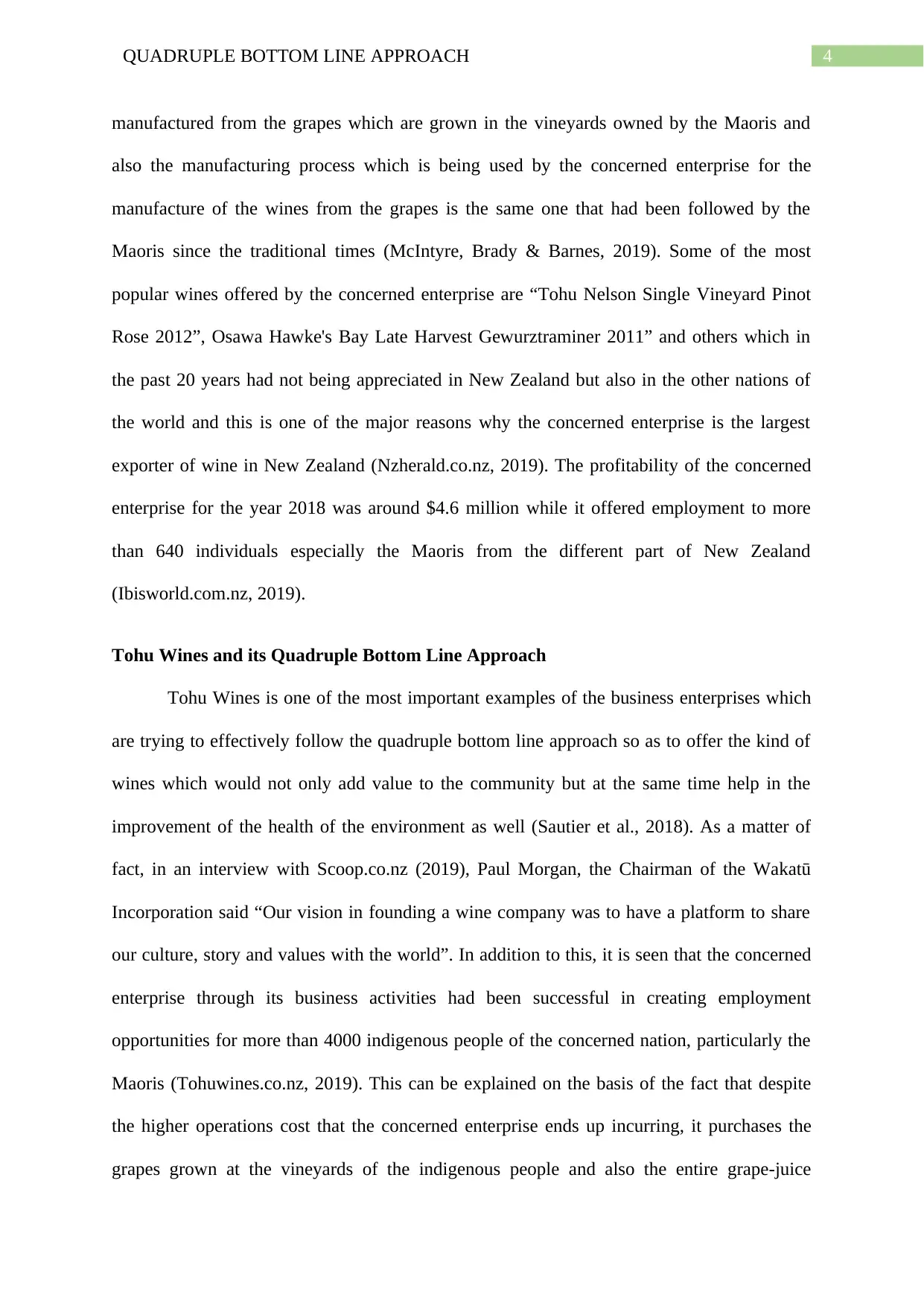
4QUADRUPLE BOTTOM LINE APPROACH
manufactured from the grapes which are grown in the vineyards owned by the Maoris and
also the manufacturing process which is being used by the concerned enterprise for the
manufacture of the wines from the grapes is the same one that had been followed by the
Maoris since the traditional times (McIntyre, Brady & Barnes, 2019). Some of the most
popular wines offered by the concerned enterprise are “Tohu Nelson Single Vineyard Pinot
Rose 2012”, Osawa Hawke's Bay Late Harvest Gewurztraminer 2011” and others which in
the past 20 years had not being appreciated in New Zealand but also in the other nations of
the world and this is one of the major reasons why the concerned enterprise is the largest
exporter of wine in New Zealand (Nzherald.co.nz, 2019). The profitability of the concerned
enterprise for the year 2018 was around $4.6 million while it offered employment to more
than 640 individuals especially the Maoris from the different part of New Zealand
(Ibisworld.com.nz, 2019).
Tohu Wines and its Quadruple Bottom Line Approach
Tohu Wines is one of the most important examples of the business enterprises which
are trying to effectively follow the quadruple bottom line approach so as to offer the kind of
wines which would not only add value to the community but at the same time help in the
improvement of the health of the environment as well (Sautier et al., 2018). As a matter of
fact, in an interview with Scoop.co.nz (2019), Paul Morgan, the Chairman of the Wakatū
Incorporation said “Our vision in founding a wine company was to have a platform to share
our culture, story and values with the world”. In addition to this, it is seen that the concerned
enterprise through its business activities had been successful in creating employment
opportunities for more than 4000 indigenous people of the concerned nation, particularly the
Maoris (Tohuwines.co.nz, 2019). This can be explained on the basis of the fact that despite
the higher operations cost that the concerned enterprise ends up incurring, it purchases the
grapes grown at the vineyards of the indigenous people and also the entire grape-juice
manufactured from the grapes which are grown in the vineyards owned by the Maoris and
also the manufacturing process which is being used by the concerned enterprise for the
manufacture of the wines from the grapes is the same one that had been followed by the
Maoris since the traditional times (McIntyre, Brady & Barnes, 2019). Some of the most
popular wines offered by the concerned enterprise are “Tohu Nelson Single Vineyard Pinot
Rose 2012”, Osawa Hawke's Bay Late Harvest Gewurztraminer 2011” and others which in
the past 20 years had not being appreciated in New Zealand but also in the other nations of
the world and this is one of the major reasons why the concerned enterprise is the largest
exporter of wine in New Zealand (Nzherald.co.nz, 2019). The profitability of the concerned
enterprise for the year 2018 was around $4.6 million while it offered employment to more
than 640 individuals especially the Maoris from the different part of New Zealand
(Ibisworld.com.nz, 2019).
Tohu Wines and its Quadruple Bottom Line Approach
Tohu Wines is one of the most important examples of the business enterprises which
are trying to effectively follow the quadruple bottom line approach so as to offer the kind of
wines which would not only add value to the community but at the same time help in the
improvement of the health of the environment as well (Sautier et al., 2018). As a matter of
fact, in an interview with Scoop.co.nz (2019), Paul Morgan, the Chairman of the Wakatū
Incorporation said “Our vision in founding a wine company was to have a platform to share
our culture, story and values with the world”. In addition to this, it is seen that the concerned
enterprise through its business activities had been successful in creating employment
opportunities for more than 4000 indigenous people of the concerned nation, particularly the
Maoris (Tohuwines.co.nz, 2019). This can be explained on the basis of the fact that despite
the higher operations cost that the concerned enterprise ends up incurring, it purchases the
grapes grown at the vineyards of the indigenous people and also the entire grape-juice
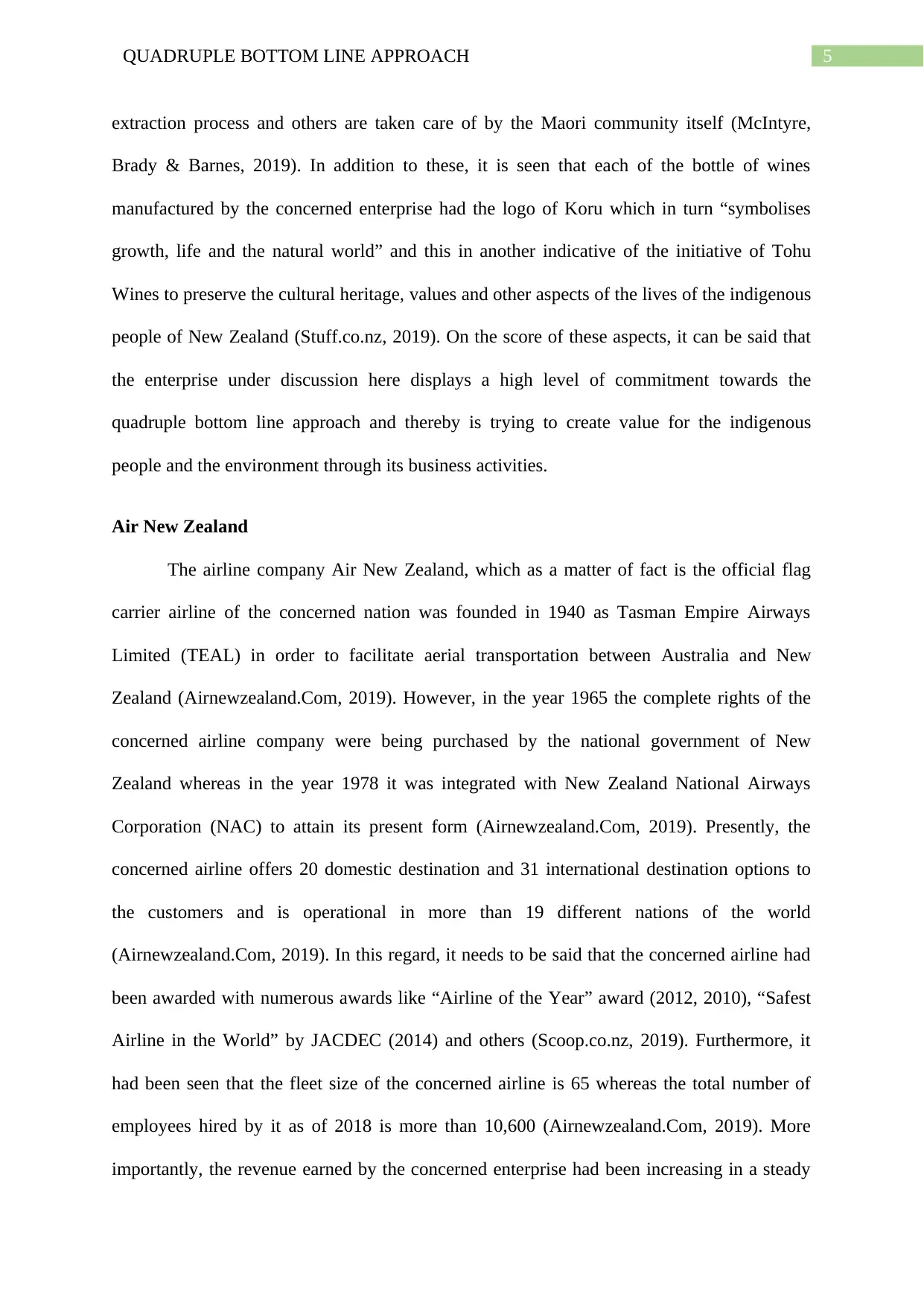
5QUADRUPLE BOTTOM LINE APPROACH
extraction process and others are taken care of by the Maori community itself (McIntyre,
Brady & Barnes, 2019). In addition to these, it is seen that each of the bottle of wines
manufactured by the concerned enterprise had the logo of Koru which in turn “symbolises
growth, life and the natural world” and this in another indicative of the initiative of Tohu
Wines to preserve the cultural heritage, values and other aspects of the lives of the indigenous
people of New Zealand (Stuff.co.nz, 2019). On the score of these aspects, it can be said that
the enterprise under discussion here displays a high level of commitment towards the
quadruple bottom line approach and thereby is trying to create value for the indigenous
people and the environment through its business activities.
Air New Zealand
The airline company Air New Zealand, which as a matter of fact is the official flag
carrier airline of the concerned nation was founded in 1940 as Tasman Empire Airways
Limited (TEAL) in order to facilitate aerial transportation between Australia and New
Zealand (Airnewzealand.Com, 2019). However, in the year 1965 the complete rights of the
concerned airline company were being purchased by the national government of New
Zealand whereas in the year 1978 it was integrated with New Zealand National Airways
Corporation (NAC) to attain its present form (Airnewzealand.Com, 2019). Presently, the
concerned airline offers 20 domestic destination and 31 international destination options to
the customers and is operational in more than 19 different nations of the world
(Airnewzealand.Com, 2019). In this regard, it needs to be said that the concerned airline had
been awarded with numerous awards like “Airline of the Year” award (2012, 2010), “Safest
Airline in the World” by JACDEC (2014) and others (Scoop.co.nz, 2019). Furthermore, it
had been seen that the fleet size of the concerned airline is 65 whereas the total number of
employees hired by it as of 2018 is more than 10,600 (Airnewzealand.Com, 2019). More
importantly, the revenue earned by the concerned enterprise had been increasing in a steady
extraction process and others are taken care of by the Maori community itself (McIntyre,
Brady & Barnes, 2019). In addition to these, it is seen that each of the bottle of wines
manufactured by the concerned enterprise had the logo of Koru which in turn “symbolises
growth, life and the natural world” and this in another indicative of the initiative of Tohu
Wines to preserve the cultural heritage, values and other aspects of the lives of the indigenous
people of New Zealand (Stuff.co.nz, 2019). On the score of these aspects, it can be said that
the enterprise under discussion here displays a high level of commitment towards the
quadruple bottom line approach and thereby is trying to create value for the indigenous
people and the environment through its business activities.
Air New Zealand
The airline company Air New Zealand, which as a matter of fact is the official flag
carrier airline of the concerned nation was founded in 1940 as Tasman Empire Airways
Limited (TEAL) in order to facilitate aerial transportation between Australia and New
Zealand (Airnewzealand.Com, 2019). However, in the year 1965 the complete rights of the
concerned airline company were being purchased by the national government of New
Zealand whereas in the year 1978 it was integrated with New Zealand National Airways
Corporation (NAC) to attain its present form (Airnewzealand.Com, 2019). Presently, the
concerned airline offers 20 domestic destination and 31 international destination options to
the customers and is operational in more than 19 different nations of the world
(Airnewzealand.Com, 2019). In this regard, it needs to be said that the concerned airline had
been awarded with numerous awards like “Airline of the Year” award (2012, 2010), “Safest
Airline in the World” by JACDEC (2014) and others (Scoop.co.nz, 2019). Furthermore, it
had been seen that the fleet size of the concerned airline is 65 whereas the total number of
employees hired by it as of 2018 is more than 10,600 (Airnewzealand.Com, 2019). More
importantly, the revenue earned by the concerned enterprise had been increasing in a steady
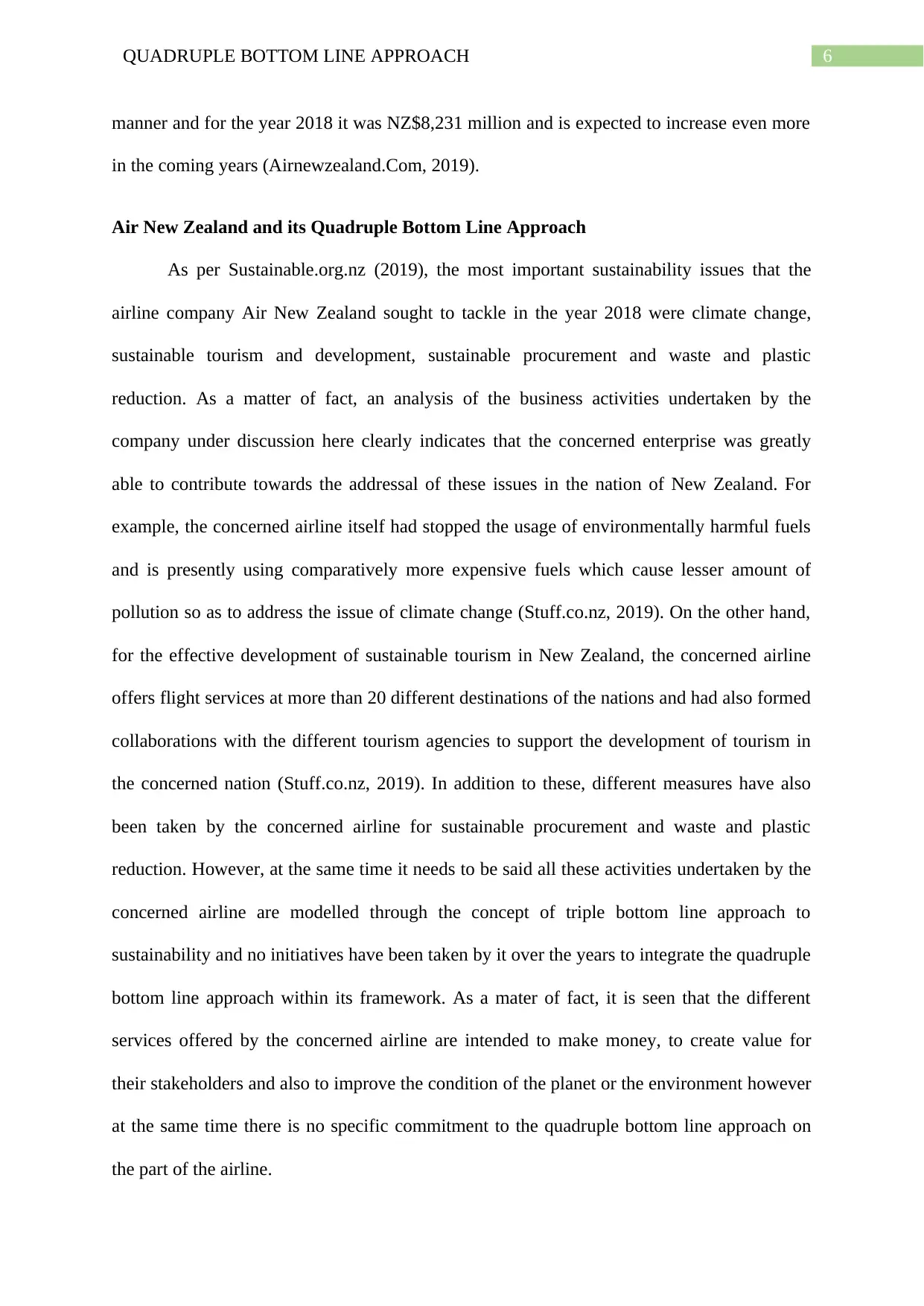
6QUADRUPLE BOTTOM LINE APPROACH
manner and for the year 2018 it was NZ$8,231 million and is expected to increase even more
in the coming years (Airnewzealand.Com, 2019).
Air New Zealand and its Quadruple Bottom Line Approach
As per Sustainable.org.nz (2019), the most important sustainability issues that the
airline company Air New Zealand sought to tackle in the year 2018 were climate change,
sustainable tourism and development, sustainable procurement and waste and plastic
reduction. As a matter of fact, an analysis of the business activities undertaken by the
company under discussion here clearly indicates that the concerned enterprise was greatly
able to contribute towards the addressal of these issues in the nation of New Zealand. For
example, the concerned airline itself had stopped the usage of environmentally harmful fuels
and is presently using comparatively more expensive fuels which cause lesser amount of
pollution so as to address the issue of climate change (Stuff.co.nz, 2019). On the other hand,
for the effective development of sustainable tourism in New Zealand, the concerned airline
offers flight services at more than 20 different destinations of the nations and had also formed
collaborations with the different tourism agencies to support the development of tourism in
the concerned nation (Stuff.co.nz, 2019). In addition to these, different measures have also
been taken by the concerned airline for sustainable procurement and waste and plastic
reduction. However, at the same time it needs to be said all these activities undertaken by the
concerned airline are modelled through the concept of triple bottom line approach to
sustainability and no initiatives have been taken by it over the years to integrate the quadruple
bottom line approach within its framework. As a mater of fact, it is seen that the different
services offered by the concerned airline are intended to make money, to create value for
their stakeholders and also to improve the condition of the planet or the environment however
at the same time there is no specific commitment to the quadruple bottom line approach on
the part of the airline.
manner and for the year 2018 it was NZ$8,231 million and is expected to increase even more
in the coming years (Airnewzealand.Com, 2019).
Air New Zealand and its Quadruple Bottom Line Approach
As per Sustainable.org.nz (2019), the most important sustainability issues that the
airline company Air New Zealand sought to tackle in the year 2018 were climate change,
sustainable tourism and development, sustainable procurement and waste and plastic
reduction. As a matter of fact, an analysis of the business activities undertaken by the
company under discussion here clearly indicates that the concerned enterprise was greatly
able to contribute towards the addressal of these issues in the nation of New Zealand. For
example, the concerned airline itself had stopped the usage of environmentally harmful fuels
and is presently using comparatively more expensive fuels which cause lesser amount of
pollution so as to address the issue of climate change (Stuff.co.nz, 2019). On the other hand,
for the effective development of sustainable tourism in New Zealand, the concerned airline
offers flight services at more than 20 different destinations of the nations and had also formed
collaborations with the different tourism agencies to support the development of tourism in
the concerned nation (Stuff.co.nz, 2019). In addition to these, different measures have also
been taken by the concerned airline for sustainable procurement and waste and plastic
reduction. However, at the same time it needs to be said all these activities undertaken by the
concerned airline are modelled through the concept of triple bottom line approach to
sustainability and no initiatives have been taken by it over the years to integrate the quadruple
bottom line approach within its framework. As a mater of fact, it is seen that the different
services offered by the concerned airline are intended to make money, to create value for
their stakeholders and also to improve the condition of the planet or the environment however
at the same time there is no specific commitment to the quadruple bottom line approach on
the part of the airline.
Paraphrase This Document
Need a fresh take? Get an instant paraphrase of this document with our AI Paraphraser
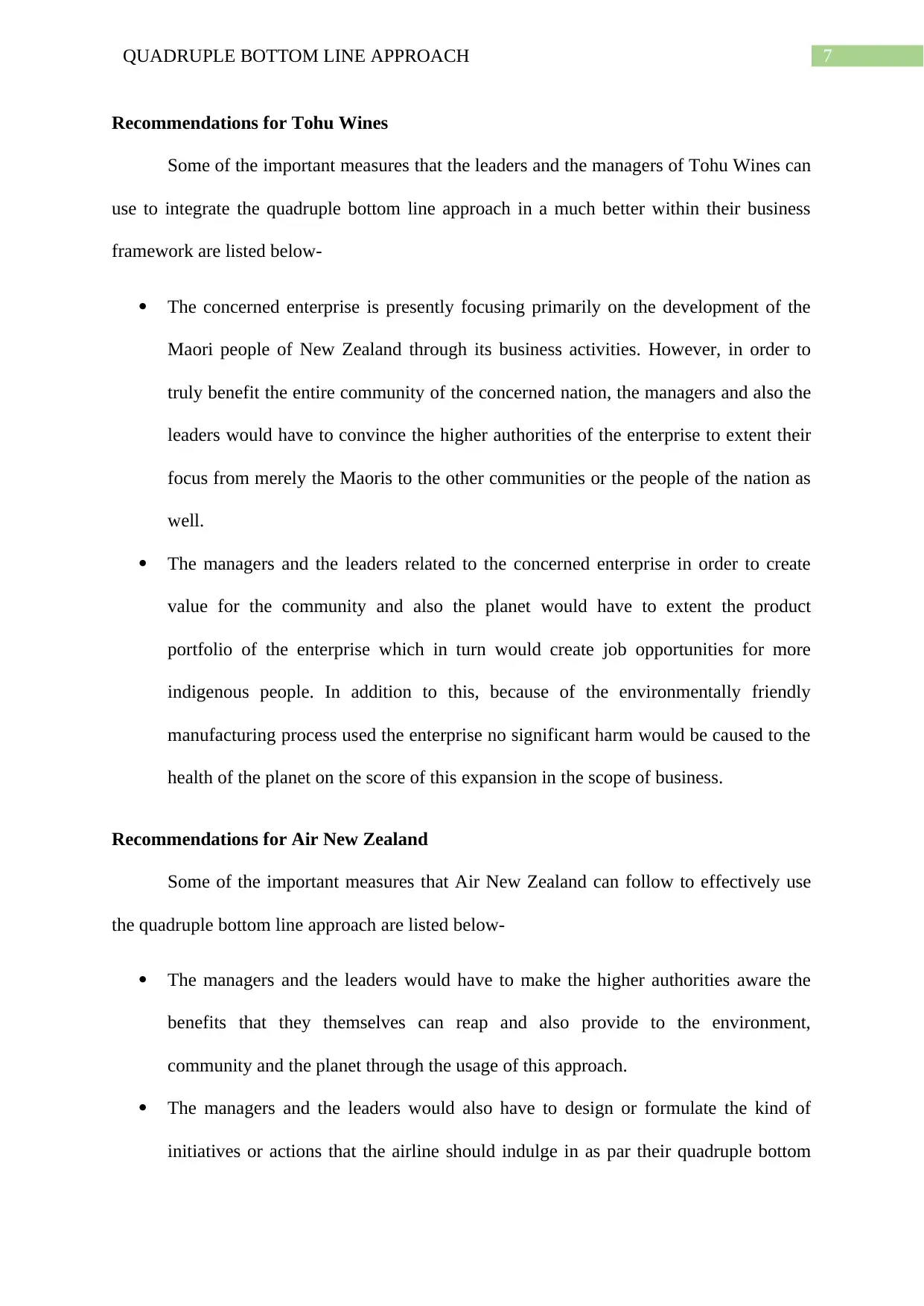
7QUADRUPLE BOTTOM LINE APPROACH
Recommendations for Tohu Wines
Some of the important measures that the leaders and the managers of Tohu Wines can
use to integrate the quadruple bottom line approach in a much better within their business
framework are listed below-
The concerned enterprise is presently focusing primarily on the development of the
Maori people of New Zealand through its business activities. However, in order to
truly benefit the entire community of the concerned nation, the managers and also the
leaders would have to convince the higher authorities of the enterprise to extent their
focus from merely the Maoris to the other communities or the people of the nation as
well.
The managers and the leaders related to the concerned enterprise in order to create
value for the community and also the planet would have to extent the product
portfolio of the enterprise which in turn would create job opportunities for more
indigenous people. In addition to this, because of the environmentally friendly
manufacturing process used the enterprise no significant harm would be caused to the
health of the planet on the score of this expansion in the scope of business.
Recommendations for Air New Zealand
Some of the important measures that Air New Zealand can follow to effectively use
the quadruple bottom line approach are listed below-
The managers and the leaders would have to make the higher authorities aware the
benefits that they themselves can reap and also provide to the environment,
community and the planet through the usage of this approach.
The managers and the leaders would also have to design or formulate the kind of
initiatives or actions that the airline should indulge in as par their quadruple bottom
Recommendations for Tohu Wines
Some of the important measures that the leaders and the managers of Tohu Wines can
use to integrate the quadruple bottom line approach in a much better within their business
framework are listed below-
The concerned enterprise is presently focusing primarily on the development of the
Maori people of New Zealand through its business activities. However, in order to
truly benefit the entire community of the concerned nation, the managers and also the
leaders would have to convince the higher authorities of the enterprise to extent their
focus from merely the Maoris to the other communities or the people of the nation as
well.
The managers and the leaders related to the concerned enterprise in order to create
value for the community and also the planet would have to extent the product
portfolio of the enterprise which in turn would create job opportunities for more
indigenous people. In addition to this, because of the environmentally friendly
manufacturing process used the enterprise no significant harm would be caused to the
health of the planet on the score of this expansion in the scope of business.
Recommendations for Air New Zealand
Some of the important measures that Air New Zealand can follow to effectively use
the quadruple bottom line approach are listed below-
The managers and the leaders would have to make the higher authorities aware the
benefits that they themselves can reap and also provide to the environment,
community and the planet through the usage of this approach.
The managers and the leaders would also have to design or formulate the kind of
initiatives or actions that the airline should indulge in as par their quadruple bottom
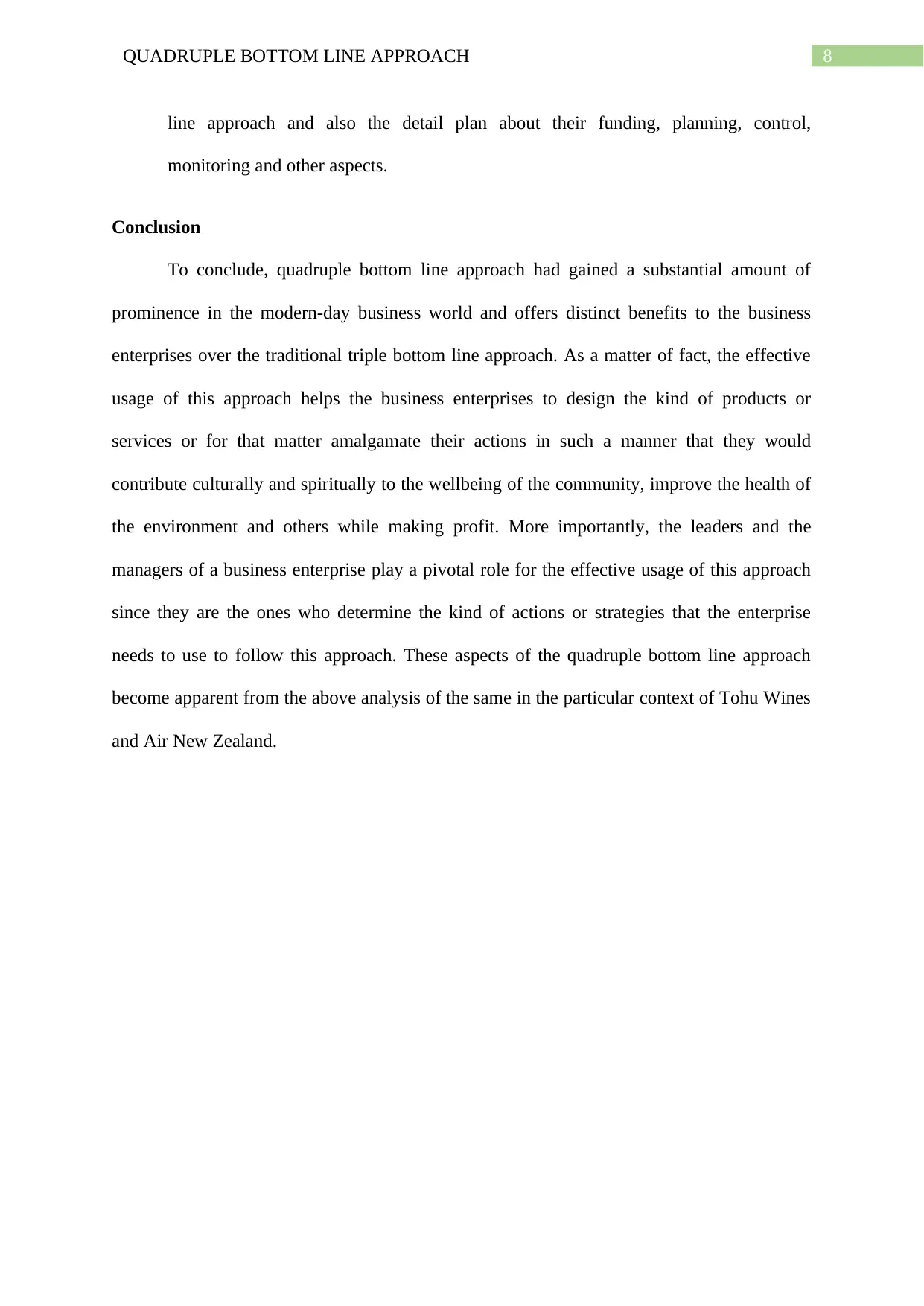
8QUADRUPLE BOTTOM LINE APPROACH
line approach and also the detail plan about their funding, planning, control,
monitoring and other aspects.
Conclusion
To conclude, quadruple bottom line approach had gained a substantial amount of
prominence in the modern-day business world and offers distinct benefits to the business
enterprises over the traditional triple bottom line approach. As a matter of fact, the effective
usage of this approach helps the business enterprises to design the kind of products or
services or for that matter amalgamate their actions in such a manner that they would
contribute culturally and spiritually to the wellbeing of the community, improve the health of
the environment and others while making profit. More importantly, the leaders and the
managers of a business enterprise play a pivotal role for the effective usage of this approach
since they are the ones who determine the kind of actions or strategies that the enterprise
needs to use to follow this approach. These aspects of the quadruple bottom line approach
become apparent from the above analysis of the same in the particular context of Tohu Wines
and Air New Zealand.
line approach and also the detail plan about their funding, planning, control,
monitoring and other aspects.
Conclusion
To conclude, quadruple bottom line approach had gained a substantial amount of
prominence in the modern-day business world and offers distinct benefits to the business
enterprises over the traditional triple bottom line approach. As a matter of fact, the effective
usage of this approach helps the business enterprises to design the kind of products or
services or for that matter amalgamate their actions in such a manner that they would
contribute culturally and spiritually to the wellbeing of the community, improve the health of
the environment and others while making profit. More importantly, the leaders and the
managers of a business enterprise play a pivotal role for the effective usage of this approach
since they are the ones who determine the kind of actions or strategies that the enterprise
needs to use to follow this approach. These aspects of the quadruple bottom line approach
become apparent from the above analysis of the same in the particular context of Tohu Wines
and Air New Zealand.
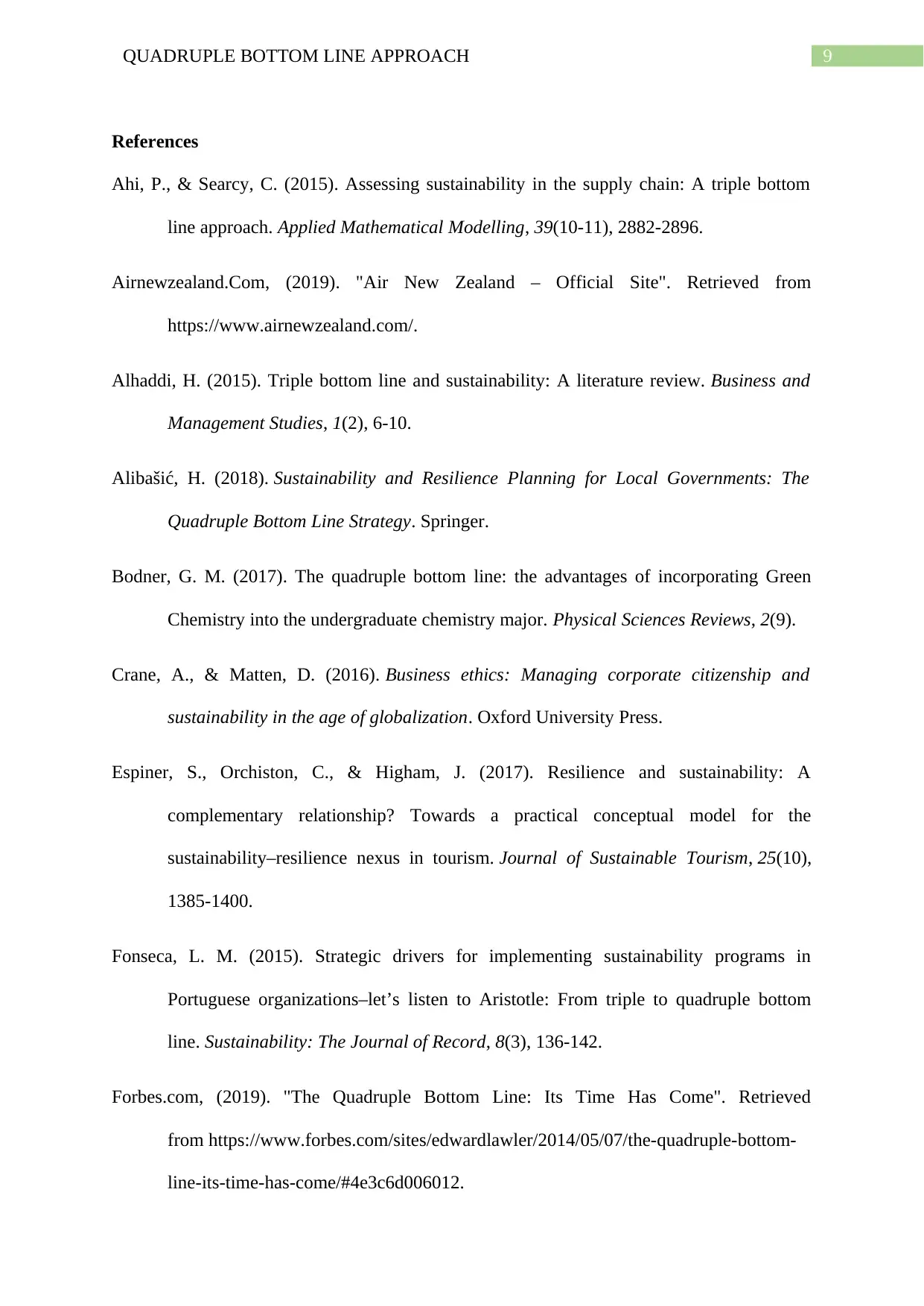
9QUADRUPLE BOTTOM LINE APPROACH
References
Ahi, P., & Searcy, C. (2015). Assessing sustainability in the supply chain: A triple bottom
line approach. Applied Mathematical Modelling, 39(10-11), 2882-2896.
Airnewzealand.Com, (2019). "Air New Zealand – Official Site". Retrieved from
https://www.airnewzealand.com/.
Alhaddi, H. (2015). Triple bottom line and sustainability: A literature review. Business and
Management Studies, 1(2), 6-10.
Alibašić, H. (2018). Sustainability and Resilience Planning for Local Governments: The
Quadruple Bottom Line Strategy. Springer.
Bodner, G. M. (2017). The quadruple bottom line: the advantages of incorporating Green
Chemistry into the undergraduate chemistry major. Physical Sciences Reviews, 2(9).
Crane, A., & Matten, D. (2016). Business ethics: Managing corporate citizenship and
sustainability in the age of globalization. Oxford University Press.
Espiner, S., Orchiston, C., & Higham, J. (2017). Resilience and sustainability: A
complementary relationship? Towards a practical conceptual model for the
sustainability–resilience nexus in tourism. Journal of Sustainable Tourism, 25(10),
1385-1400.
Fonseca, L. M. (2015). Strategic drivers for implementing sustainability programs in
Portuguese organizations–let’s listen to Aristotle: From triple to quadruple bottom
line. Sustainability: The Journal of Record, 8(3), 136-142.
Forbes.com, (2019). "The Quadruple Bottom Line: Its Time Has Come". Retrieved
from https://www.forbes.com/sites/edwardlawler/2014/05/07/the-quadruple-bottom-
line-its-time-has-come/#4e3c6d006012.
References
Ahi, P., & Searcy, C. (2015). Assessing sustainability in the supply chain: A triple bottom
line approach. Applied Mathematical Modelling, 39(10-11), 2882-2896.
Airnewzealand.Com, (2019). "Air New Zealand – Official Site". Retrieved from
https://www.airnewzealand.com/.
Alhaddi, H. (2015). Triple bottom line and sustainability: A literature review. Business and
Management Studies, 1(2), 6-10.
Alibašić, H. (2018). Sustainability and Resilience Planning for Local Governments: The
Quadruple Bottom Line Strategy. Springer.
Bodner, G. M. (2017). The quadruple bottom line: the advantages of incorporating Green
Chemistry into the undergraduate chemistry major. Physical Sciences Reviews, 2(9).
Crane, A., & Matten, D. (2016). Business ethics: Managing corporate citizenship and
sustainability in the age of globalization. Oxford University Press.
Espiner, S., Orchiston, C., & Higham, J. (2017). Resilience and sustainability: A
complementary relationship? Towards a practical conceptual model for the
sustainability–resilience nexus in tourism. Journal of Sustainable Tourism, 25(10),
1385-1400.
Fonseca, L. M. (2015). Strategic drivers for implementing sustainability programs in
Portuguese organizations–let’s listen to Aristotle: From triple to quadruple bottom
line. Sustainability: The Journal of Record, 8(3), 136-142.
Forbes.com, (2019). "The Quadruple Bottom Line: Its Time Has Come". Retrieved
from https://www.forbes.com/sites/edwardlawler/2014/05/07/the-quadruple-bottom-
line-its-time-has-come/#4e3c6d006012.
Secure Best Marks with AI Grader
Need help grading? Try our AI Grader for instant feedback on your assignments.

10QUADRUPLE BOTTOM LINE APPROACH
Hussain, N., Rigoni, U., & Orij, R. P. (2018). Corporate governance and sustainability
performance: Analysis of triple bottom line performance. Journal of Business
Ethics, 149(2), 411-432.
Ibisworld.com.nz, (2019). “Wine Production – New Zealand Industry Research Reports |
IBISWorld”. Retrieved from https://www.ibisworld.com.nz/industry-trends/nz-
market-research reports/manufacturing/wine-production.html
Lawler, E. E. (2018). Organization Development and Talent Management: Beyond the Triple
Bottom-Line. In Enacting Values-Based Change (pp. 115-121). Palgrave Macmillan,
Cham.
McIntyre, J., Brady, M., & Barnes, J. (2019). “They are among the Best Workers, Learning
the Ways of a Vineyard Quickly”: Aboriginal People, Drinking, and Labor in the
Early Australian Wine Industry. Global Food History, 1-22.
Nzherald.co.nz, (2019). “Export award to Tohu Wines”. Retrieved from
https://www.nzherald.co.nz/business/news/article.cfm?c_id=3&objectid=3501500
Paling, C., Hooper, P., & Thomas, C. (2016). The Sustainability of Air Transport. In The
Geographies of Air Transport (pp. 141-156). Routledge.
Sautier, M., Legun, K. A., Rosin, C., & Campbell, H. (2018). Sustainability: A tool for
governing wine production in New Zealand?. Journal of cleaner production, 179,
347-356.
Scoop.co.nz, (2019). "Air New Zealand Wins New Zealand’S Top Sustainability Award |
Scoop News". Retrieved from http://www.scoop.co.nz/stories/BU1611/S00756/air-
new-zealand-wins-new-zealands-top-sustainability-award.htm.
Hussain, N., Rigoni, U., & Orij, R. P. (2018). Corporate governance and sustainability
performance: Analysis of triple bottom line performance. Journal of Business
Ethics, 149(2), 411-432.
Ibisworld.com.nz, (2019). “Wine Production – New Zealand Industry Research Reports |
IBISWorld”. Retrieved from https://www.ibisworld.com.nz/industry-trends/nz-
market-research reports/manufacturing/wine-production.html
Lawler, E. E. (2018). Organization Development and Talent Management: Beyond the Triple
Bottom-Line. In Enacting Values-Based Change (pp. 115-121). Palgrave Macmillan,
Cham.
McIntyre, J., Brady, M., & Barnes, J. (2019). “They are among the Best Workers, Learning
the Ways of a Vineyard Quickly”: Aboriginal People, Drinking, and Labor in the
Early Australian Wine Industry. Global Food History, 1-22.
Nzherald.co.nz, (2019). “Export award to Tohu Wines”. Retrieved from
https://www.nzherald.co.nz/business/news/article.cfm?c_id=3&objectid=3501500
Paling, C., Hooper, P., & Thomas, C. (2016). The Sustainability of Air Transport. In The
Geographies of Air Transport (pp. 141-156). Routledge.
Sautier, M., Legun, K. A., Rosin, C., & Campbell, H. (2018). Sustainability: A tool for
governing wine production in New Zealand?. Journal of cleaner production, 179,
347-356.
Scoop.co.nz, (2019). "Air New Zealand Wins New Zealand’S Top Sustainability Award |
Scoop News". Retrieved from http://www.scoop.co.nz/stories/BU1611/S00756/air-
new-zealand-wins-new-zealands-top-sustainability-award.htm.

11QUADRUPLE BOTTOM LINE APPROACH
Scoop.co.nz, (2019). “Tohu, first Māori-owned wine company celebrates 20 years | Scoop
News”. Retrieved from http://www.scoop.co.nz/stories/BU1808/S00898/tohu-first-
maori-owned-wine-company-celebrates-20-years.htm
Simons, R. A., Robinson, S., Lee, E., & Bragg, A. (2017). The quadruple bottom line: tenant
views of corporate responsibility in green office buildings. Journal of Sustainable
Real Estate, 9(1), 153-171.
Stuff.co.nz, (2019). "'The World's Least Unsustainable Airline': Air New Zealand's Climate
Dilemma". Retrieved from https://www.stuff.co.nz/business/107455477/the-worlds-
least-unsustainable-airline-air-new-zealands-climate-dilemma.
Stuff.co.nz, (2019). “Cultural cache with Tohu wine”. Retrieved from
http://www.stuff.co.nz/marlborough-express/your-marlborough/8161416/Cultural-
cache-with-Tohu-wine
Sustainable.org.nz, (2019). "6 Key Learnings From Air NZ Sustainability Framework Launch
- Sustainable Business Network". Retrieved
from https://sustainable.org.nz/sustainable-business-news/5-key-learnings-from-air-
nz-sustainability-framework-launch/.
Svensson, G., Høgevold, N., Ferro, C., Varela, J. C. S., Padin, C., & Wagner, B. (2016). A
triple bottom line dominant logic for business sustainability: framework and empirical
findings. Journal of Business-to-Business Marketing, 23(2), 153-188.
Tohuwines.co.nz, (2019). "Our Wine Making History — Tohu Wines". Retrieved from
https://www.tohuwines.co.nz/who-we-are.
Walters, F., & Takamura, J. (2015). The decolonized quadruple bottom line: a framework for
developing indigenous innovation. Wicazo sa review, 30(2), 77-99.
Scoop.co.nz, (2019). “Tohu, first Māori-owned wine company celebrates 20 years | Scoop
News”. Retrieved from http://www.scoop.co.nz/stories/BU1808/S00898/tohu-first-
maori-owned-wine-company-celebrates-20-years.htm
Simons, R. A., Robinson, S., Lee, E., & Bragg, A. (2017). The quadruple bottom line: tenant
views of corporate responsibility in green office buildings. Journal of Sustainable
Real Estate, 9(1), 153-171.
Stuff.co.nz, (2019). "'The World's Least Unsustainable Airline': Air New Zealand's Climate
Dilemma". Retrieved from https://www.stuff.co.nz/business/107455477/the-worlds-
least-unsustainable-airline-air-new-zealands-climate-dilemma.
Stuff.co.nz, (2019). “Cultural cache with Tohu wine”. Retrieved from
http://www.stuff.co.nz/marlborough-express/your-marlborough/8161416/Cultural-
cache-with-Tohu-wine
Sustainable.org.nz, (2019). "6 Key Learnings From Air NZ Sustainability Framework Launch
- Sustainable Business Network". Retrieved
from https://sustainable.org.nz/sustainable-business-news/5-key-learnings-from-air-
nz-sustainability-framework-launch/.
Svensson, G., Høgevold, N., Ferro, C., Varela, J. C. S., Padin, C., & Wagner, B. (2016). A
triple bottom line dominant logic for business sustainability: framework and empirical
findings. Journal of Business-to-Business Marketing, 23(2), 153-188.
Tohuwines.co.nz, (2019). "Our Wine Making History — Tohu Wines". Retrieved from
https://www.tohuwines.co.nz/who-we-are.
Walters, F., & Takamura, J. (2015). The decolonized quadruple bottom line: a framework for
developing indigenous innovation. Wicazo sa review, 30(2), 77-99.

12QUADRUPLE BOTTOM LINE APPROACH
1 out of 13
Related Documents
Your All-in-One AI-Powered Toolkit for Academic Success.
+13062052269
info@desklib.com
Available 24*7 on WhatsApp / Email
![[object Object]](/_next/static/media/star-bottom.7253800d.svg)
Unlock your academic potential
© 2024 | Zucol Services PVT LTD | All rights reserved.





